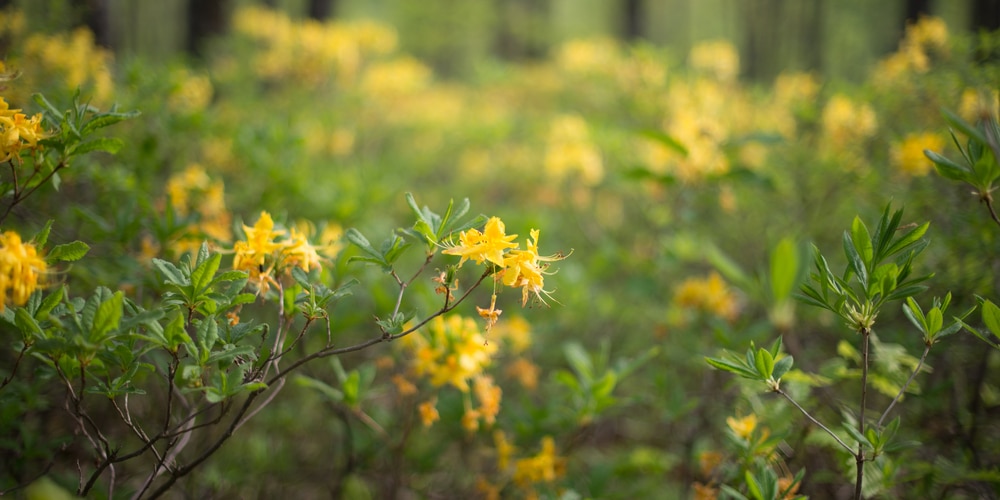The good news is that once you’ve figured out what the issue is, you’ll be able to take steps to help your plant regain its health. Let’s look at why your azalea leaves may be turning yellow.
It can be frustrating when your Azalea plant’s foliage starts to turn yellow, especially if you’re not sure what’s causing the problem. Many things can cause foliage discoloring, including incorrect soil pH, poor drainage, lack of water, or nitrogen deficiency.
Causes of yellowing leaves

As mentioned above, there are four main reasons that the leaves of an azalea plant turn yellow. One of the most common is a deficiency of nutrients or incorrect soil pH. Here are some tips to help you figure out what’s wrong with your plants and solve the problem.
Lack of Nitrogen in the Soil
When the soil is lacking in nitrogen, your plant’s leaves will start to turn yellow. This is common if your plant is growing in poor-quality soil. Sandy soils are often lacking in nitrogen.
If you’ve recently added organic matter to the soil as mulch, this may have resulted in a nitrogen deficiency. Garden waste, including wood bark, leaves, and grass clippings, requires nitrogen to decompose. It can leach the soil of nitrogen and leave your plant deficient in this vital nutrient.
To rectify this problem, you can use a fertilizer that contains nitrogen. This will help improve the quality of the soil and help your plant’s leaves turn green again. You should also remove any decomposing mulch from the area surrounding your plant. Only add well-rotted garden waste to the soil, which has been composted first.
Soil pH
Another common problem is that the soil pH range is too alkaline. This can cause the plant’s foliage to turn yellow due to a lack of iron. Azaleas require soil with a pH range of between 4 and 6 to thrive. Aim for a soil pH of as close to 5.5 as possible. Growing plants will be difficult if you live in an area with naturally chalky soil or with high levels of lime present in the earth. You’ll need to make adjustments to the earth to grow an azalea plant.
If you think the cause of your plant’s yellowing leaves is caused by incorrect pH levels, you may like to test your soil. Once you find out the soil pH, you can add the nutrients your azalea needs. Be aware that changing the pH of the earth isn’t a long-term solution. In time the soil will revert back to its original pH range.
Underwatering
If your plant’s soil feels very dry, it’s likely been underwatered, which is a common cause of yellowing leaves. Azaleas aren’t very tolerant of drought and should be watered frequently. Aim to keep the soil moist so that your plant thrives.
Azaleas do best when planted in well-draining soil. If you live in a dry climate, you’ll need to water your outdoor Azaleas regularly. It may help to add an inch of mulch to the topsoil surrounding your plant. This will help lock in moisture and cool down the soil. Mulch helps to reduce evaporation, which means your plant’s roots will be kept cool and receive the water they need.
Overwatering leading to root rot
If you’ve overwatered your Azalea plant, or the water can’t drain away from the plant’s roots, it may have caused root rot. When the plant’s roots begin to rot, it cannot get the nutrients it needs from the soil. This causes the plant’s foliage to turn yellow.
Ensure you plant your azalea in well-draining soil. You can add some perlite to houseplants or organic matter to outside plants. If you think your plant has become waterlogged, you may need to dig it up and treat its roots with a fungicide. The plant can then be re-potted using new soil and a new pot. Throw away the old soil so that the infection doesn’t spread to other plants.
Migration/Transplant
If you move your azalea plant from inside to outside, or otherwise transplant it, that can cause a shock and yellowing of the leaves.
Conclusion
Your azaleas leaves may be turning yellow for a number or reasons. Azaleas that have yellowing foliage have either been under or overwatered or are growing in incorrect soil. When the plant’s leaves turn yellow, this may signify a nitrogen deficit, or the earth may be too alkaline.
If there’s a drought or you’ve forgotten to water your plant, this can cause discoloring of the leaves. Overwatering or slow draining soil will mean the soil becomes waterlogged, which causes root rot.
Related: Grass that turns yellow in winter